What programs clean the disk from unnecessary stuff. Three reasons to clean the disk.
The hard disk of the computer is not rubber, and each user may encounter a situation where one or all local disks will be full. In addition to the fact that you cannot save new files, it may also affect the computer’s work, especially if the C drive is clogged. In many cases, part of the memory is taken up by completely unnecessary information that you either simply forgot or do not know about its existence. Let's figure out how to clean the hard drive from unnecessary files, and do not harm the system.
What files are unnecessary?
First of all, this category includes so-called “computer trash”:
- temporary information;
- data that the browser stores;
- some registry entries.
Many programs leave behind temporary or backup files that are never used afterwards, but remain on the computer. Browsers also like to save a lot of unnecessary information about the sites you visited. Well, not a small fraction of computer garbage is made up of unused shortcuts, information in the clipboard, the remaining information from remote applications And so on. All this over time creates a load on the system disk, which leads to the appearance of lags on the computer.
Unused programs setup files and much more from the contents of the hard disk only does what takes up memory. Therefore, it is necessary to take time to restore order on the computer.
How to get rid of junk files?
First you need to study the local disks for unnecessary installation information, movies, photos, music and be sure to empty the recycle bin - this can significantly increase the amount of free memory on the hard drive.
It is worth noting that the procedure for deleting unused files is not a sin to be engaged in as a preventive measure, without waiting for the memory to fail. We will consider the 3 most effective ways getting rid of unnecessary data:
- removal of programs;
- use of system tools;
- use of the CCleaner utility.
For reliability, you can consistently apply all of these methods.
This article will help you burn movies to DVD -
Removing unnecessary software
It often happens that you install the program for one-time use and forget to remove it. And in some cases, along with the necessary software, several additional utilities are installed on the computer. In any case, periodically it is useful to check the list of installed software, since many of them can not only take up much space, but also work in backgroundusing system resources.
Go to the control panel and select "Uninstall a program."
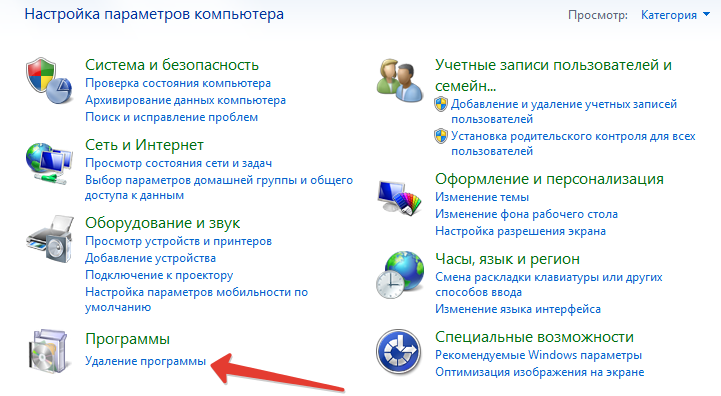
Now we begin to carefully study the list. installed programs. Many of the names may seem unfamiliar, but you should not immediately begin to remove them, since this may be the software or the driver you need for the system. It is better to search the Internet for what they are needed, and then decide their future. To remove a program, select it and top bar Click on the appropriate caption.
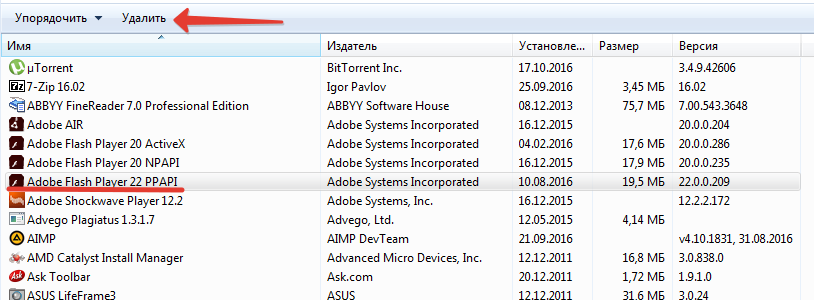
Use of system tools
In the operating room windows system the possibility of cleaning from "junk" files. To do this, select the desired drive and click on it with the right mouse button. AT context menu Click "Properties".
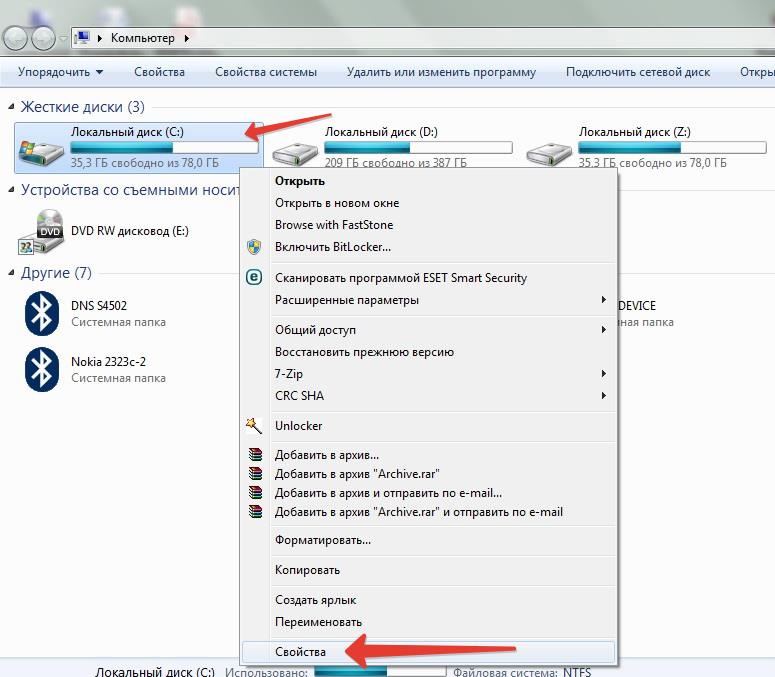
In the window that opens, click on the button "Disk Cleanup".
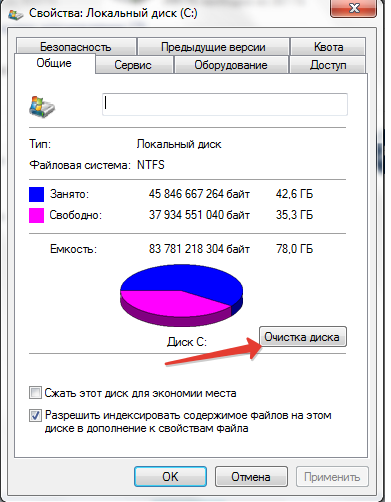
After assessing the amount of memory that can be freed up (it may take some time), you are given the opportunity to choose which types of files to delete. You can safely check all the checkboxes - if it were unsafe, the system would not suggest deleting them. Nevertheless, it is better to pay attention to what you note - it may turn out that you need this data. Putting a tick, you will see how much memory will be released. Click OK, confirm deletion and wait.

It’s so easy and simple to delete unused files from hard drivewithout resorting to the use of additional software.
Using CCleaner
CCleaner program is considered the most reliable tool in terms of cleaning the computer from debris. It can always be downloaded for free from the official site. It is extremely simple and easy to use.
For cleaning in the CCleaner, the corresponding tab must be selected. In addition, pay attention to the tabs "Windows" and "Applications", where you can find out what these or other unnecessary files belong to. If necessary, affix or uncheck. Click the "Analysis" button.
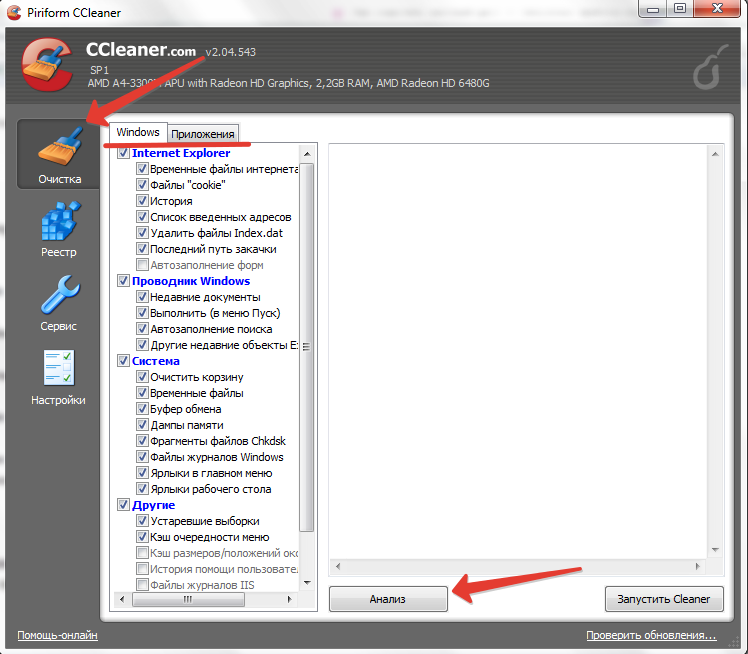
After analysis, you will see how much memory will be freed, and what kind of data will be deleted. Click the "Run Cleaner" button.

In addition, in CCleaner, you can check and correct registry errors.
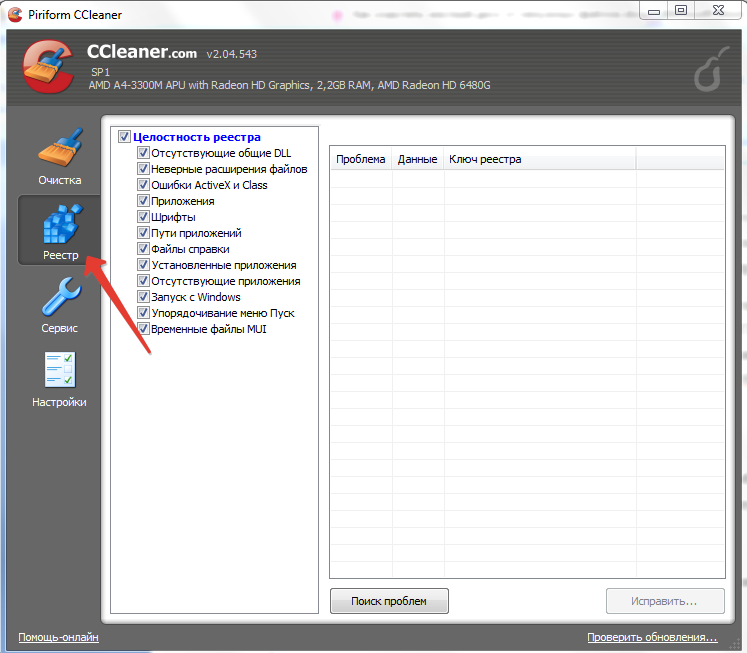
Conclusion
These methods of removing unnecessary files have proven themselves well on Windows 7, Windows 8 and Windows 10, however, they are applicable even to Windows XP. Remember that such procedures will not only free up a lot of memory, but also improve system performance.
How to clean the local C drive from garbage (unnecessary files)In OS Windows there is a folder Tempin which temporary files are stored (these are temporary files that are created when installing programs, updating, files needed during the operation of any program for storing temporary data and cache and other files that were needed by the operating system or program as temporary data storage) . During the work in this folder there are a lot of unnecessary files that are essentially garbage. The size of these files is sometimes reaches tens of gigabytes.
Naturally there is no point in storing this garbage on the hard disk. Useful from time to time clean the hard disk from garbage. Below I will tell how to clean the drive C, in order not to harm the operating system and to free up the local disk from unnecessary files.
There are 2 options for cleaning the disk. The first option is to clean the disk using special tools, the second is to manually clean the disk.
Manual disc cleaning is more efficient and reliable way, but at the same time requiring a greater number of actions and at least minimal training. Cleaning with the help of utilities does not require much time, picking in the system settings and any computer knowledge. However, this method is not always effective in cases, for example, when viruses are hidden in a folder with garbage. In this case, the virus files are likely to remain in place.
Cleaning disc C from garbage with the help of utility CCleaner
Consider how to clean the disc from debris using the program for cleaning the disk CCleaner. This is a very necessary and necessary program, which you simply need to use, at least once every two weeks. You can download it.
In the left part of the program window select the tab Cleaner (cleaning the hard disk). Tick marks elements for analyzing the presence of unused files and garbage. It is better to leave everything here unchanged. Press the button Analyzeto start the analysis. It will take some time.
After analyzing the files on the hard disk, the program will display a list of unnecessary files and an approximate total amount of free space on the C drive. Click the button Run cleaner to start cleaning the disk from garbage.
In the appeared window it is warned that it will not be possible to restore the deleted files. Click OK to continue cleaning.
After the hard drive is cleared, a report will be displayed. Now you can close the program. In the above example, almost 4.5 gigabytes of disk space on disk C were freed.
You can also use TuneUp Utilities to clean your disk. You can download it.
I use both the first and second through time ...
How to properly clean the local drive C manuallyTo clean the C drive manually, you must first. Now you need to manually remove the garbage from temporary windows folders. It is advisable to clean the system disk after booting in safe mode. To do this, when you turn on the computer, press F8 and select the line Safe mode.
The location of folders for temporary files is different in Windows XP and Windows 7. Below are the folders that need to be cleaned in Windows XP and Windows 7.
To clean the system disk of debris go to each of the following folders and delete all the attached files and folders. To select the entire contents of the folder at once, go into it through My Computer and press the key combination CTRL + A (or CTRL + F for the Russian keyboard layout). All files and folders will stand out. After that, press SHIFT + DEL to immediately delete these files permanently, rather than moving them to the trash. After cleaning the folders, empty the trash.
In Windows XP, these are folders (some may not be):
1. C: \\ Windows \\ Temp
2. C: \\ Documents and Settings \\% username% \\ Local Settings \\ Temp
3. C: \\ Documents and Settings \\ FOX \\ Local Settings \\ Temporary Internet Files
4. C: \\ Documents and Settings \\ FOX \\ Local Settings \\ Application Data \\ Opera \\ Opera \\ cache
5. C: \\ Temp
In Windows Vista and Windows 7, these are folders (some may not be):
1. C: \\ Windows \\ Temp
2. C: \\ Temp
3. C: \\ Users \\% username% \\ AppData \\ Local \\ Temp
4. C: \\ Users \\% username% \\ AppData \\ Local \\ Opera \\ Opera \\ cache
5. C: \\ Users \\% username% \\ AppData \\ Local \\ Temp
6. C: \\ Users \\% username% \\ AppData \\ Local \\ Opera \\ Opera \\ cache
where% username% is the username
Share the record in your social networks!
When copying material back link to our site is required!
Without free space on the hard drive, especially on the system partition (drive C), that the computer that the user "lives badly." Can not install new game, useful program, and Windows without a reserve of 10-20GB on the hard disk can not function correctly.
"Memory sinks" - unnecessary files and folders, registry entries - on a PC and laptop a huge amount. And many of them appear and increase in volume on their own, without user participation, during the operation of the Windows operating system. Alas, this is its specificity.
But be that as it may, clean hDD from the "digital stuff" is still completely possible. And most importantly, you need. Otherwise, the comfortable use of the computer will remain only in the pink dreams of its owner (that is, in yours).
Here is a selection of guides on how to clean a disk using the standard system options and special utilities.
"Cleaning" on drive C
1. Press both keys simultaneously - “Win + R”.
2. In the “Open” line, in the “Run” panel, type the cleanmgr directive (a system utility that allows you to clean the C drive and other hard disk partitions).
3. Click “OK”.
4. In the drop-down list (click on the arrow) select the disk that you want to clean (to delete files in C, proceed first!).
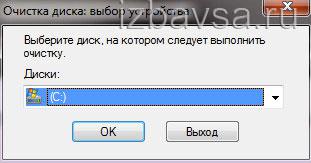
5. Wait while the system will analyze the directories of the selected partition.
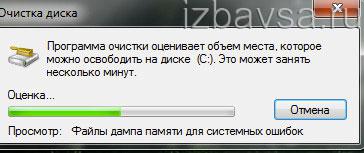
6. In the cleanup settings window, in the “Delete the following files:” box, check the boxes in the boxes opposite the items that you want to clear. Click “OK”.
Attention! Turn on the Cleanup component windows updates»Allows you to get rid of the Windows.old folder (file storages for previous OS updates).

Also on the Advanced tab, you can use other functions that perform file deletion in directories. To do this, click the “Clear” button in one of the tab blocks (or in both in turn).
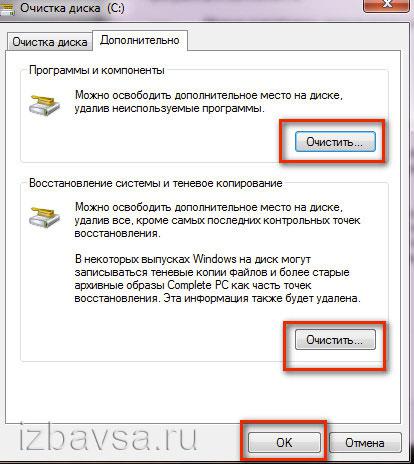
“Programs and Components” - Uninstall unnecessary programs. Click on the application in the list. And then click "Uninstall / Change." The software uninstaller appears on the display. Follow his instructions.
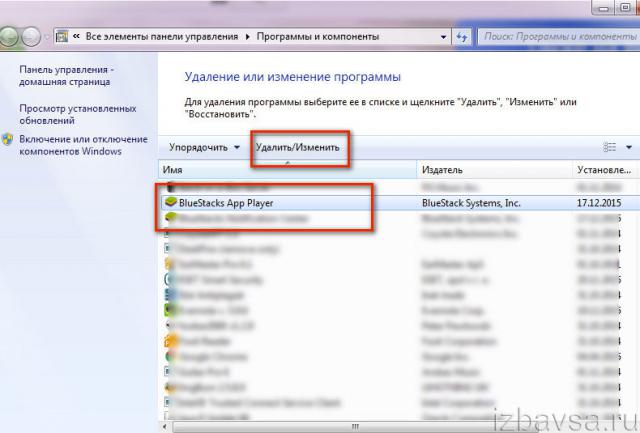
"Restore ..." - delete all points windows recoveryexcept the last. These elements can occupy a substantial volume. Run the function and in the additional window click "Delete".

Cleaning the Temp folder
The “Temp” directory is a repository of temporary folders and files. If you clean it, you can not only add free space to your hard drive, and in some cases get rid of the virus. Feel free to completely delete its contents.
1. Open the "Run" panel (simultaneously press the "Win" and "R" keys).

2. In the "Open" field, enter -% temp%. Press "Enter" or click "OK".
3. Go to the window that opens and press the "Alt" key.
4. In the menu that appears (see the top panel), open the “Tools” section by clicking the mouse and select “Folder Options ...”.
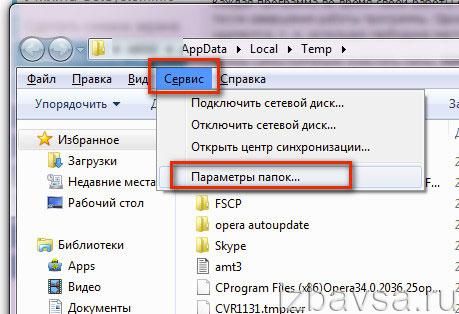
5. Click the “View” tab.
6. In the "Advanced Settings" box, scroll down. Turn on the button next to the last option "Show hidden files ...".
7. Click “Apply” and “OK”. Now in “Temp”, as well as in other folders and partitions of the hard disk, hidden objects will be displayed. So, it will be possible to get rid of all the files stored in this directory.
8. Now that all objects are visible, select them: click on one of the files, and then press "Ctrl + A". Right click on the highlighted list. Select the "Delete" option from the menu.

9. After cleaning, do not forget to empty the “Trash”.
Deleting "heavy" system files
Note. The objects in question perform certain functions in the system. Before deleting / disabling, make sure that you do not need them. In particular, the software reserve for random access memory and hibernation mode (a kind of sleep mode).
Pagefile.sys
(RAM swap file)
1. Click the Windows icon in the taskbar.
2. In the "Start" panel that opens, select "Control Panel".
3. Go to the System and Security section, and then to the System subsection.
4. In the block on the right, click on the “Advanced system settings” item.

5. In the new window, on the "Advanced" tab, in the "Performance" block, click the "Parameters" button.
6. In the panel that opens, open the Advanced tab again.
7. In the "Virtual Memory" block, click "Change ...".
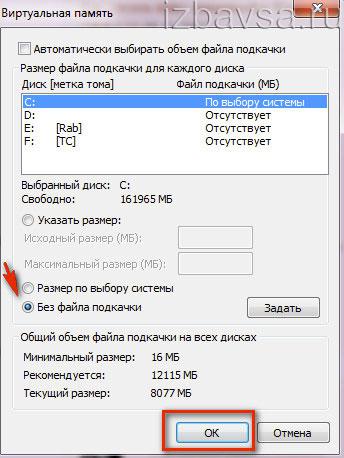
8. If necessary, uncheck the box next to the "Automatically select volume ..." option.
9. Enable the “Without paging file” option (click on the radio button). Click “Ok”.
10. In the additional window, also click “OK”. The system will restart.
Hiberfil.sys
In this file, the system saves all the data and settings of the PC before it goes into sleep mode, so that it can be quickly restored after activation. It can have a fairly solid volume - 5-10 GB.
To remove it from the system partition, do the following:
1. Press simultaneously “Win” and “R” (the “Run” window will open).
2. In the "Open" line, enter the command - powercfg -h off.

3. Click “OK”.
Automatic cleaning
Special cleaning programs quickly and efficiently relieve the system from the accumulated software junk. They clean the browser cache, the Temp folder, delete duplicate files, useless objects, clean up the registry. But, unfortunately, with their help it is impossible to neutralize the system "heavyweights" - the files windows.old, Pagefile.sys, Hiberfil.sys; the folders Winsxs. Be sure to take this into account.
Consider the two most popular software tools.

Professional Windows cleaner from the Russian developer ChemTable. It is distributed conditionally-free (the term of the demo version is 30 days). Cleans and optimizes the registry. Imposes cleanliness on disks, fixes software problems.
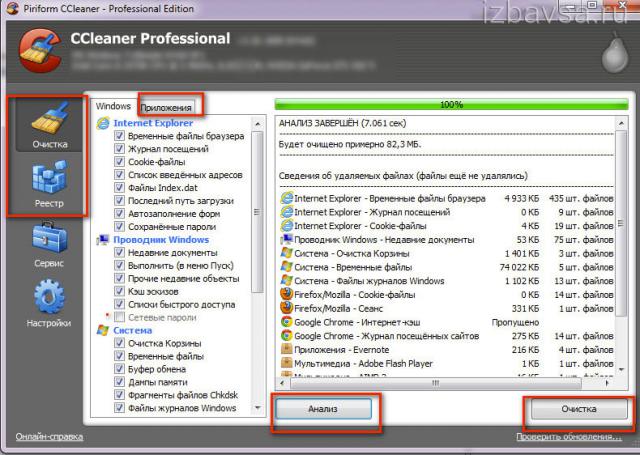
The brainchild of English programmers from the company Piriform LTD. It has a large number of cleaning settings (clipboard, cache, cookies, recent documents, etc.). Before correcting mistakes and deleting unnecessary entries, suggests backup copy registry. But at the same time it performs “cleaning” delicately, without violating the integrity and performance of the operating system.
Using Uninstall Software
Removing programs from the operating system using standard tools does not always work perfectly. Keys remain in the registry, folders and files in directories. They lie on the hard drive as a useless load and select precious megabytes, and sometimes gigabytes, of disk space.
But in third-party uninstaller programs, this drawback is absent. On completion standard removal they neutralize all remnants of the program. Let's get acquainted with the most popular solutions from this category of software closer.

Utility from the developer ChemTable Software. It has a Russian and English interface. Distributed shareware. Performs complete removal applications. Monitors the processes and changes that occur in Windows during the installation of programs.
1. Run the utility.
2. Select the desired application by clicking.
3. Click the Remove Program button (located in the top panel).
4. Follow the instructions of the built-in uninstaller and Soft Organizer (disk analysis, removal of residues).

One of the most "skillful" uninstallers. Created by VS Revo Group. It is distributed in two versions: Pro - paid; Free - free. Supports three modes of scanning residues after removal. When the Advanced mode is enabled, a thorough analysis of all disk directories and the registry is performed.
- Left click on the icon of the application to be deleted in the utility window.
- Click the “Delete” button in the top pane.
- Follow the prompts of Revo Uninstaller.
Let only useful data be always stored on your PC! Do not forget to periodically "do the cleaning" on the hard drive.
Hard disk Completely - to make its formatting. You can do it right from under Windows, go to My Computer and select the desired disk right click. In the drop-down list, select the "Format" command. After selecting the cluster sizes and the formatting speed and depth, click OK. After some time, the operation will be completed, and disk cleaned up. However if hard disk, from which you need to remove information, system, as well as, if necessary, completely clean hard disk without the possibility of data recovery, the described option is not suitable.
To work with diskat a deeper level, you will need partition manager programs. For example, Partition Logic, Partition Manager, BootIt Next Generation, Acronis Disk Director. It is best to use special boot disks with such programs. Having booted from it (having previously set up the initial boot from the CD-ROM in the BIOS), you can format both the system and any other installed hard drive. Thus, the data from them will be deleted.
In case you need to completely clean hard disk Without the ability to recover information, run Acronis Disk Director. In the window where the list of installed hard drives and partitions on them, select the desired disk right click. In the drop-down menu, select the item "Delete data". In the window that appears, enter the settings for the delete operation and click OK.
Timely hard cleaning disk a personal computer allows not only to free up some free space, but also to improve the performance of the operating system. The presence of a large amount of unallocated space sometimes increases the speed of recording information on the hard drive.
The state of the hard disk of the computer affects the speed of Windows 7, since the system actively uses the free space of the drive for its own purposes. The disk stores the installed applications, user data, as well as temporary and service files. The trash drive is slow, slowing down the entire computer. It is time to clean up and completely clean the disc from debris.
Why do I need to clean the hard disk
Three reasons to clean the disk
- The need for free space. For the user, installed applications and Windows 7 itself needs a significant amount of free space on the drive. Many manufacturers software even indicate this parameter among the most important when describing the requirements for computer hardware.
- Stability of work. Non-existent links, “broken” files with reserved names, remnants remote programs and drivers are often the cause of system crashes and installed applications. Digital trash accumulated on the hard disk makes windows operation 7 unpredictable.
- Speed of work Empty and useless files clog up the disk and create additional load on the file system, slowing down Windows 7.
Where does garbage come from
- Caching Network browsers use a hard disk for "caching", that is, intermediate storage of information downloaded from the Internet, as well as improving speed and stability. Unfortunately, they do not like to erase the recorded information after work.
- Temporary files. Many applications create temporary storage of service information on the disk: current settings, clipboard, intermediate copies and much more. They also do not seek to clean up this information after themselves - the disk is clogged.
- Remains of remote applications. The uninstallation procedure does not always work flawlessly, often there are incomprehensible files and entire folders that have not been needed for a long time by the user.
- Windows 7 files. operating system creates many temporary, intermediate and work files. Emergency exit, occasional crashes and software conflicts turn many of them into digital trash.
Manual cleaning methods
Using the utility "Disk Cleanup"
The system utility for cleaning the hard drive erases temporary and unused files, as well as cleans the trash.
To launch the utility, press the Start button, then in the left column, select All Programs. In the list that opens, click "Standard", then the folder "System Tools".
The utility utilities package is located in the “Standard” section.
From the list of service utilities, select "Disk Cleanup".

A separate utility is provided for disk cleaning.
You can get to the same window using the search bar. To do this, press the "Start" button and type in search bar "Disk Cleanup". Go to the active tab with the same name.
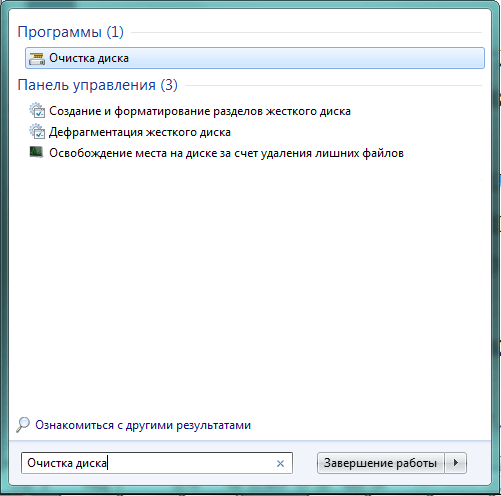
Search helps find any window system
By the very same fast way run the utility is to use the window "Run": press the key combination Win (with windows icon) and R. In the appeared small window in the input line type cleanmgr.exe and click "OK".
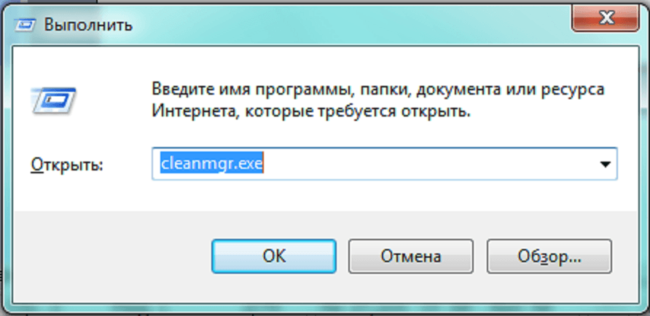
You can call the same window with the cleanmgr.exe command.
The utility starts with the appearance of a small window in which we are invited to choose one of the available logical drives for cleaning. Select the device and click "OK".
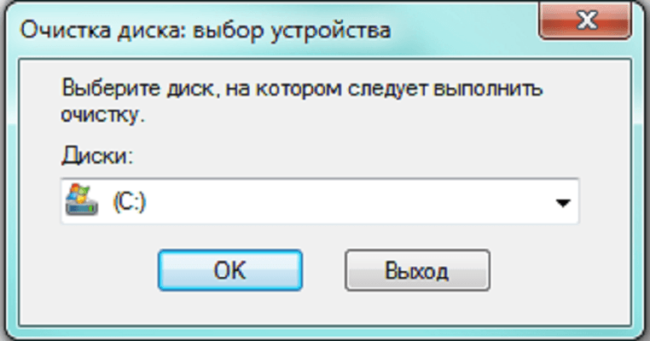
Choose a device from the list
Windows 7 immediately starts a disk scan for potential candidates for removal.

Preliminary analysis
Having finished the analysis, the utility suggests choosing categories of files to be deleted. Some of them are already marked by default, the rest do not contain marks. For greater clarity, the window contains a brief explanation of why the system perceives this information as garbage.

Choose file types
Having finished with the choice, we press the OK button, we confirm the decision. The procedure is running.
Advanced cleaning features provides the Advanced tab in the same window. However, it will only be visible to users with administrative rights. Therefore, we first restart the utility as an administrator. To do this, having reached the “Disk Cleanup” menu item that is already familiar to us, click on it right button mouse, and in the context menu that opens, select "Run as administrator".
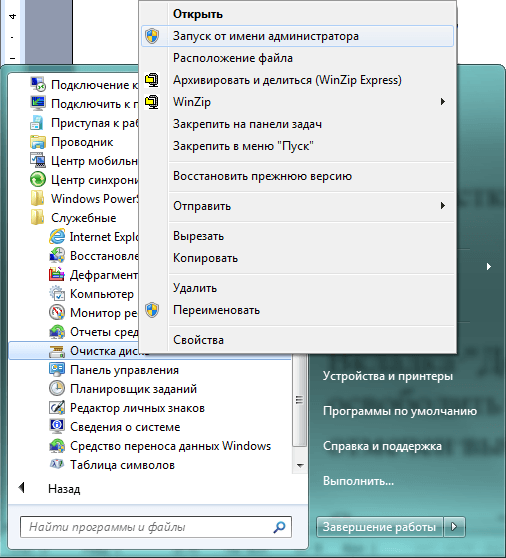
Running as administrator creates additional options.
After selecting a logical drive and completing the analysis, the “Disk Cleanup” window has acquired a new “Advanced” tab. Go to her.

There is another tab
The top button “Clear” leads to the “Programs and components” system window with the list of applications installed on the computer. One way to increase the amount of free disk space is to remove some of the applications.
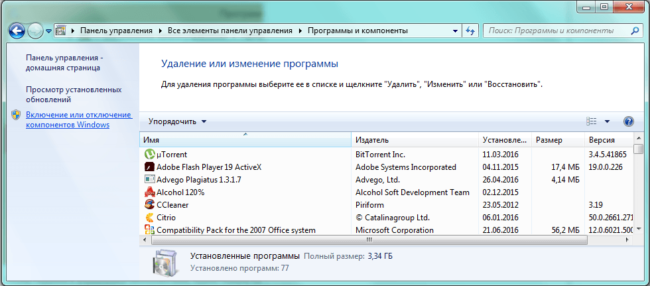
Full list of installed applications
We select applications without which we can do, and delete them from the hard disk.
The bottom button “Clear” offers to free up a part of the filled space by deleting the system restore point files and the shadow copy. Savings in this case comes at the expense of security. Additional recovery points may be useful if, for example, the latter was created on an infected malware the computer. Shadow files also store old copies of user files, which can help if major ones are damaged. Therefore, the utility offers to confirm your desire to delete this information.
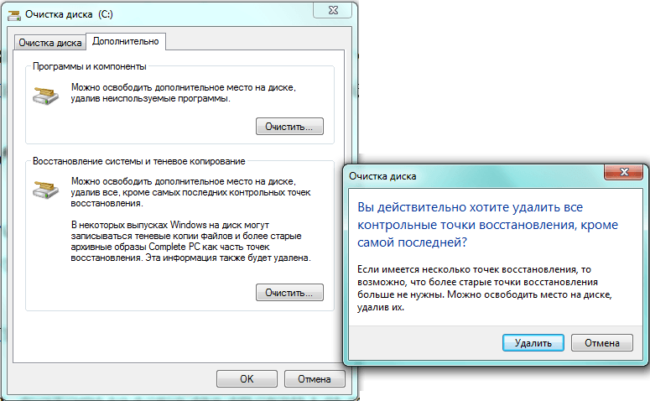
Deleting restore points is not safe
Through the "Explorer" Windows
One of the most frequently used and familiar applications to any user is Windows 7 “Explorer.” Many actions to clean up a hard disk can be performed directly from it.
Trash stores user-deleted files in case you need to restore them. This is one of the reasons for the system messages about the lack of space on the hard disk, even when a lot of information has just been deleted - everything has moved to the Trash. Clean it up.
To do this, in the "Explorer" select "Basket" and click on it with the right mouse button. In the context menu that opens, go to the line "Empty the basket."

Right-click on the "Empty Trash"
The “Conductor” will ask us whether we are sure of our desire to permanently remove what is in the “Basket” and, after confirmation, will clean it up. Disk space will be more.
We now turn to the disc itself. Already familiar to us cleaning procedure can be run from the "Explorer". To do this, first select the logical disk that we plan to release from unnecessary information, for example, the main system disk C: \\. Hovering the mouse cursor on it, press the right button, and in the appeared context menu select the line “Properties”.

Choose "Properties"
Properties window: Local disk (C :) ”contains several tabs. First, go to "General". Here you can see the data on the availability of free space on the drive, as well as the “Disk Cleanup” button we need. We press it, we get to the familiar window of the profile utility.

Press the cleaning button
The “Service” tab contains buttons that launch other useful functions:
- "Run scan" - scan the disk and search for errors.
- "Perform defragmentation" - grouping information more convenient for file system in a way.
- “Archive ...” is an opportunity to create a copy of important information on another medium in the form of an archive.

Little utilities
After cleaning the main disk in the same way you need to do with the other logical devices.
The speed of the system will increase significantly if you free up enough space on the system disk (C: \\), for example, by transferring user information to other devices using the "Explorer".
System settings
To reduce the size of temporary files created by Windows 7, you can change some system settings. However, this should be done by experienced users, since incorrect edits can disrupt the operation of the system.
Reduce the size of the paging file. Part of the disk space is used by the system for the virtual expansion of RAM. The created swap file has a significant size, approximately equal to the amount of RAM. For most applications, reducing the amount of virtual memory will not lead to negative consequences, so you can reduce it.
Press the "Start" button, in the search bar type "System" and go to the active line with the same name in the list of search results. In the opened "System" large window, click on the tab "Advanced System Settings", which is located on the left. In a small window "System Properties" go to the tab "Advanced", in which we press the top screen button "Parameters", related to the item "Speed". The "Speed Options" window opens.
In the window you can see the volume of the paging file. To reduce it, you need to press the "Change" button and set a new size or location on other disk devices.
Then you can disable the hibernation function. This feature is especially useful for laptop owners. In normal sleep mode, the main energy consumers of the computer (monitor, processor, hard disk) are turned off, but the RAM is not de-energized. This allows you to quickly start working from the same place where it was interrupted, but is fraught with problems if the battery sits down - the data in the RAM will be lost. The hibernation utility saves the contents of the RAM to the hard disk and completely turns off the computer. When you resume work, the data is again loaded into RAM.
The advantage of hibernation over sleep mode is non-volatility, and the disadvantage is the need to create on the hard disk. large file to store the contents of RAM. Therefore, if the user does not plan to use hibernation, it can be disabled, than to free up additional free space.
Click "Start" and enter in the search bar "Power". Go to the tab of the same name.

Go to the active line with the desired name
In the power plan selection window, the current mode is highlighted with a switch label. Click on the active line “Power Plan Setup” next to it.

Select the setting of the current plan
Now you need to turn off the computer to sleep. To do this, in the drop-down lists “Put the computer into sleep mode” select the option “Never”, and then press the button “Save changes”.
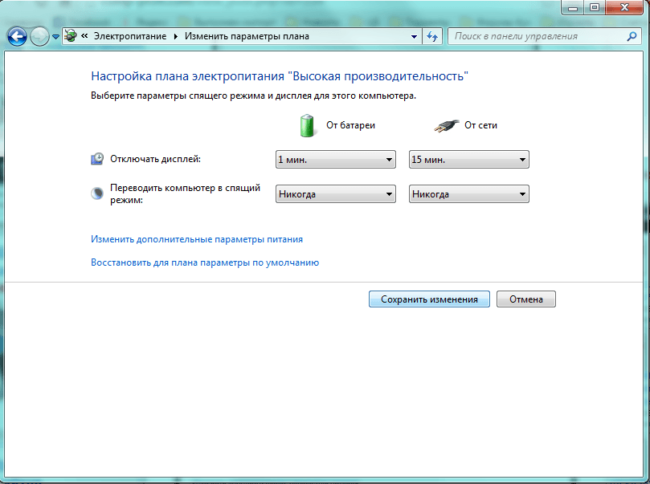
Save changes
In the same window, select the tab “Change advanced power settings”, located just below. A small window "Power" appears with a list of parameters in the main part. We find “Dream” among them and consistently set the values “Never”.

Permanently deprive the computer of sleep
Now the hibernation file will not be created. But you need to erase the one that is already on the disk. To do this, use the window "Run", which is called a combination of Win + R. In the input line, type the command powercfg –hibernate –off and press the “OK” button.
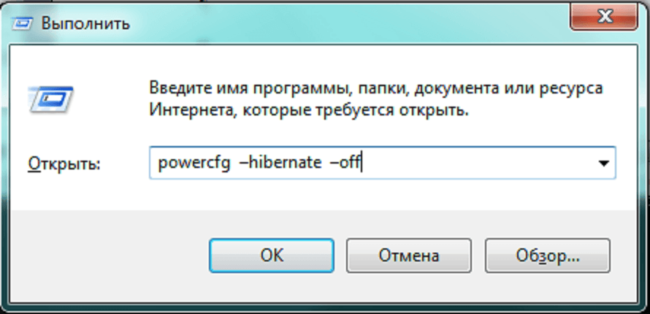
We erase the hibernation file
If you later need to undo the changes, you will need to use the powercfg –hibernate –on command.
Special programs for cleaning garbage
CCleaner
One of best programs CCleaner hard drive care even limited free version has great functionality. The application interface is organized in a convenient matrix form, simple and straightforward. The first tab is called “Cleaning” and contains Windows and “Applications” tabs, each of which contains a list of potentially garbage groups of files created by system utilities or applications. The default user is offered the safest option to choose what is considered superfluous information, but to change everything is quite simple: just put or unmark the box next to the name of the file group.
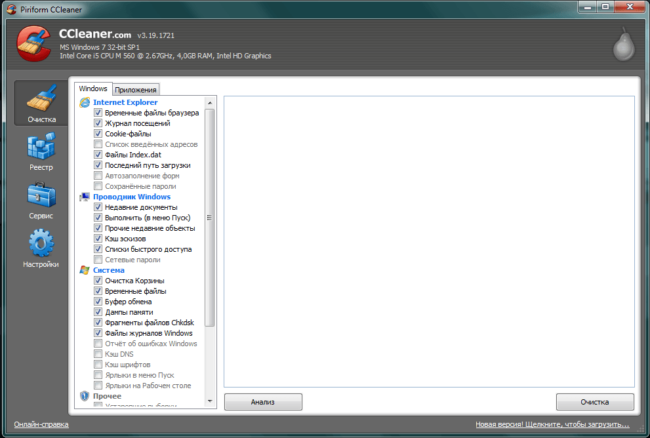
Having determined the list, it is possible to estimate the potential volume of the released space, for which we press the "Analysis" button.
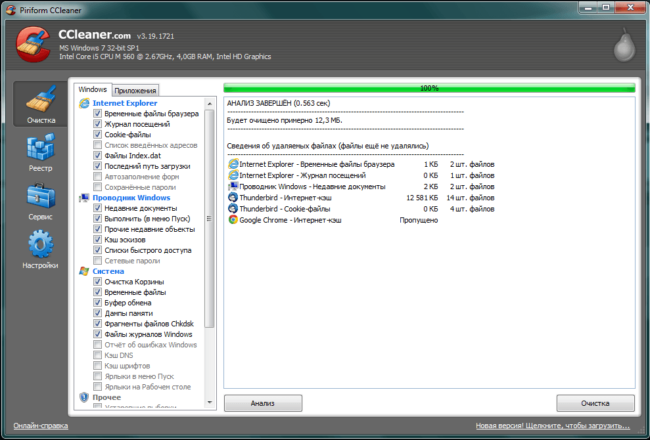
Analysis will reveal hidden reserves.
If the results of the analysis we are not satisfied with, we can reconsider the selection options in the tabs. It may be worth clearing an extra group. Otherwise, click "Cleaning", confirm your intention and start cleaning.

Click "OK" to confirm
CCleaner also provides a handy tool for uninstalling unnecessary applications. The “Uninstall a program” utility is placed in the “Service” folder. The list occupies the main part of the window, contains all the basic information about the applications and two options for deletion. The “Uninstall” on-screen button launches the built-in uninstallation utilities of the applications themselves, “Delete” forcibly erases the program and its traces in the system.

Removal of programs is organized very conveniently.
The package contains the possibility of cleaning not only the hard drive, but also the registry, startup list, as well as external media. To erase confidential information without the possibility of recovery, you can use the Erase Disk utility.

Guaranteed erasure is provided by multiple passes.
An additional advantage of the CCleaner package is a flexible system of settings that allows you to set the frequency of automatic cleaning, exclusions from the rules of deletion or additional restrictions on the age of temporary files.
Video: how to install and use the program CCleaner
TuneUp Utilities (AVG PC TuneUp)
The TuneUp Utilities comprehensive system optimization package was partially renamed after the rights to it were sold to the new owner. The application consists of a large set of utilities, some of which are designed to deal with digital garbage.

The list of functions is significant
For the convenience of the user, utilities are combined into large blocks, including “Free up disk space”.

This presentation is simpler and clearer.
Using the package is very easy, the interface is simple and friendly. Of course, you should start working from the start of the scan, located in the “Maintenance” block.

Start by scanning
Then we select the block “Free up disk space” we need and run the procedures contained in it.
The main utilities for cleaning the hard disk:
- Disk Cleaner. Cleans the hard drive from unnecessary information. These are mostly temporary system files and applications.
- Disk Space Explorer. Detects hidden reserves of the disk, making a list of the hundred most capacious files on the drive.
- Duplicate Finder. Searches files in different places on the disk. Clones are found, even if they have different names.
- Browser Cleaner. A separate utility that cleans damaged and obsolete files created by one of several dozens of the most well-known browsers.

There are several tools for cleaning.
The disadvantages of TuneUp Utilities include the aggressiveness of the default settings, so it is better not to use them without adjusting in order not to lose important and necessary files or programs. It's easy to do, just select the icon in the upper right corner of the screen. In addition, many users complain about the poor performance of the disk defragmentation utility, which is set by default. It is necessary to remove it from the settings, and use other applications for defragmentation.
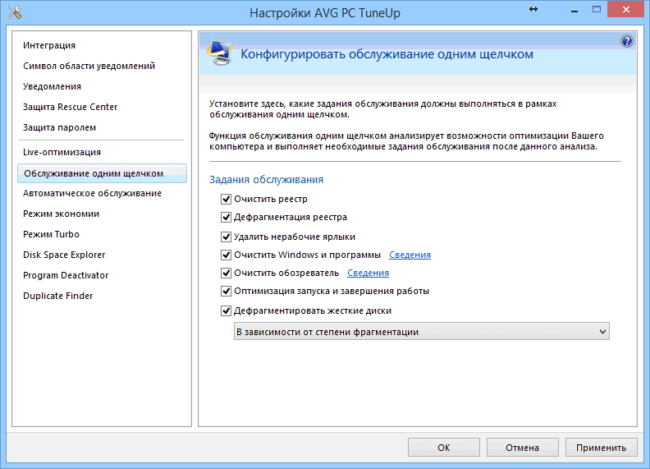
The settings window is made in a different style.
On the other hand, the package has a built-in function to create recovery points, so with due care you can not be afraid of serious consequences.

Better guard against random errors.
The package is paid, providing the opportunity to test without payment for two weeks.
Video: AVG PC TuneUp 2014 - Review and Review
RevoUninstaller
The strength of the Revo Uninstaller package is a set of utilities for uninstalling programs that thoroughly clean a computer, not only from executable modules, but also from working folders, temporary files and other traces.

You can delete programs in different ways.
The interface of the package is very friendly and understandable. For the convenience of the user, the programs installed recently have been allocated to the New Programs group. This is necessary, for example, to track "uninvited guests", which are tied to a popular free utility and installed on the computer by default.

We choose a victim from the recently appeared guests.
Deletion occurs in several stages. Initially, Revo Uninstaller performs preparatory actions: it analyzes the application to be deleted, creates a backup of the registry and, if necessary, even a system restore point.

Preparing safe and complete removal
The removal procedure is very visual, accompanied by graphic and digital data.

Everything is very clear
Having completed the removal of the main part, Revo Uninstaller scans the disk, looking for all the remaining folders and files related to the erased application. The results are presented to the user in the form of a list, in which the default marks are deleted. If you need to leave something from the list, just remove the mark.

The program faithfully scans the entire disk
Then the registry is cleared from references to deleted items.

The registry is also cleared
Among other features of the package, it is worth mentioning the browser history, Windows and MS Office browser cleanup utilities, as well as guaranteed removal of confidential information.
An additional advantage is that the package is distributed free of charge. The only requirement of the developer is to register for a certain time.
Video: Revo Uninstaller program overview
Slimcleaner
The developers of the free SlimCleaner package approached the issue of cleaning the system and optimizing computer performance from the standpoint of real democrats: best settings and programs are determined by surveys. The created network community of users shares positive and negative reviews, on the basis of which a decision is made on the utility of applications with a final grade.
The settings are very simple
The program works very quickly, the analysis will not take much time.

Analysis time is original
The scan results are presented in visual form. To get more detailed information about the contents of the file junk, double-click on the line of interest.
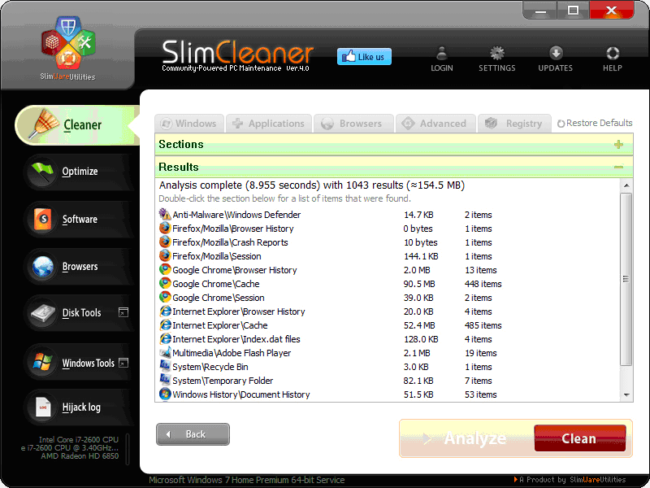
We can evaluate the potential benefits of cleaning.
The program also presents user ratings of the programs installed on the computer.

You can not only see the final grade, but also find out what it has come from, as well as read the positive and negative feedback from other users.

